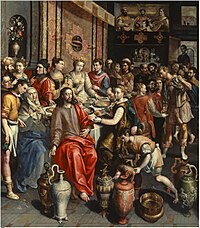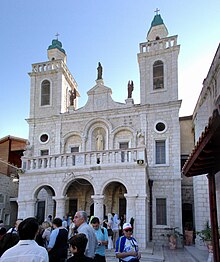Wedding at Cana

In Christianity, the transformation of water into wine at the Marriage at Cana or Wedding at Cana is the first miracle of Jesus in the Gospel of John.[1][2]
In the biblical account, Jesus and his disciples are invited to a wedding and when the wine runs out Jesus turns water into wine by performing a miracle.
The exact location of Cana has been subject to debate among biblical scholars and archeologists and several villages in Galilee are candidates.
Biblical account
John 2:1–11 states that while Jesus was attending a wedding in Cana with his disciples the party ran out of wine. Jesus' mother (unnamed in John's Gospel) told Jesus, "They have no wine," and Jesus replied, "O Woman, what have I to do with you? My hour has not yet come." His mother then said to the servants, "Do whatever he tells you" (John 2:3–5). Jesus ordered the servants to fill containers with water and to draw out some and take it to the chief steward waiter. After tasting it, and not knowing where it came from, the steward congratulated the bridegroom on departing from the custom of serving the best wine first by serving it last (John 2:6–10). John adds that: "Jesus did this, the first of his signs, in Cana of Galilee and it revealed his glory and his disciples believed in him (John 2:11)".
Interpretation

Although none of the synoptic gospels records the event, mainstream Christian tradition holds that this is the first public miracle of Jesus.[3] However in John's gospel it has considerable symbolic importance: it is the first of the seven miraculous "signs" by which Jesus's divine status is attested, and around which the gospel is structured.
It is still a matter of discussion among theologians whether the story talks of an actual material transformation of water into wine, or is a spiritual allegory. Interpreted allegorically, the good news and hope implied by the story is in the words of the Governor of the Feast when he tasted the good wine, "Everyone serves the good wine first, and then the inferior wine after the guests have become drunk. But you have kept the good wine until now" (John 2:10, NRSV). This could be interpreted by saying simply that it is always darkest before the dawn, but good things are on the way. The more usual interpretation, however, is that this is a reference to the appearance of Jesus, whom the author of the Fourth Gospel regards as being himself the good wine.[4]
The story has had considerable importance in the development of Christian pastoral theology. The gospel account of Jesus being invited to a wedding, attending, and using his divine power to save the celebrations from disaster are taken as evidence of his approval for marriage and earthly celebrations, in contrast to the more austere views of Saint Paul as found, for example, in 1 Corinthians 7.[5] It has also been used as an argument against Christian teetotalism.[6]
The miracle could also be seen as the antitype of Moses' first public miracle of changing water (the Nile river) into blood. This would establish a symbolic link between Moses as the first savior of the Jews through their escape from Egypt and Jesus as the spiritual savior of all people. [7]
Mormon views
Contrary to current mainstream Mormon belief, Mormon leader Orson Hyde taught that the marriage at Cana was Jesus' own wedding, that Jesus was a polygamist and that the sisters Mary Magdalene and Martha as well as another Mary were his wives.[8][9][10] This teaching has never been accepted as part of official Mormon doctrine by the Church of Jesus Christ of Latter-Day Saints and is not held to be true by the overwhelming majority of Mormons today.[11][12][13] Anti-Mormon critic Floyd McElveen argues against this hypothesis based on John 2:8–10 which states that the master of the ceremony at the feast (unaware of the miracle) congratulated "the bridegroom" for the wine, not Jesus and that John 2:2 states that: "Jesus and his disciples had also been invited to the wedding", and one does not get invited to his own wedding.[14]
Geography and archeology

The exact location of Cana has been subject to debate among scholars.[15] Modern scholars maintain that since the Gospel of John was addressed to Jewish Christians of the time, it isn’t likely that the evangelist would mention a place that did not exist. Villages in Galilee which are candidates for historical Cana are: Kafr Kanna, Kenet-l-Jalil (also called Khirbet Kana) and Ain Kana in Israel and Qana in Lebanon.[16]
According to the Catholic Encyclopedia of 1914, a tradition dating back to the 8th century identifies Cana with the modern Arab town of Kafr Kanna, about 7 km northeast of Nazareth, Israel.[17] Recent scholars have suggested alternatives, including the ruined village of Kenet-el-Jalil (also known as Khirbet Kana), about 9 km further north, and Ain Kana, which is closer to Nazareth and considered by some to be a better candidate on etymological grounds. While the village of Qana, in southern Lebanon, is considered an unlikely candidate for the location, many local Lebanese Christians believe the village to be the correct site.
Many ancient and modern archaeologists have sought to recover the jars used at Cana, but no specific archeological data have confirmed their discovery.
In the journal Biblical Archaeological Review, Michael Homan argues that many biblical scholars have misinterpreted early texts, translating to 'wine' when the more sensible translation is 'beer'.[18] If the celebration at Cana had served beer rather than wine, it is far less likely that archaeological evidence of the vessels will ever be discovered. As Homan discusses, beer was usually consumed quite soon after its making, leaving less evidence in the vessel containing it. Further, the tools used in its creation are often the same as those used in bread-making, obscuring their likely alternative use in beer brewing.
See also
- Chronology of Jesus
- Ministry of Jesus
- Miracles of Jesus
- Parables of Jesus
- The Wedding at Cana (Veronese) (painting)
References
- ^ H. Van der Loos, 1965 The Miracles of Jesus, E.J. Brill Press, Netherlands page 599
- ^ Dmitri Royster 1999 The miracles of Christ ISBN 0-88141-193-0 page 71
- ^ Towner, W. S. (1996). Wedding. In P. J. Achtermeier (Ed.), Harper Collins Bible dictionary (pp. 1205-1206). San Francisco: Harper
- ^ e.g. Smith, D. M. (1988). John. In Mays, J. L. (Ed.), Harper's bible commentary (pp. 1044-1076). San Francisco: Harper.
- ^ "1 corinthians 7-7 NKJV - Principles of Marriage - Now concerning". Bible Gateway. Retrieved 2012-05-16.
- ^ e.g. Geisler, N. L. (1982), A Christian Perspective on Wine-Drinking. Bibliotheca Sacra, 49
- ^ Day, Bill. The Moses Connection in John's Gospel. Mariner Publishing (1997) ISBN 0-9662080-0-5
- ^ Orson Hyde, Conference message, October 6, 1854, Journal of Discourses 2:82
- ^ Inside Today's Mormonism by Richard Abanes 2007 ISBN 0-7369-1968-6 page 239
- ^ A Disparity in Doctrine and Theology by E Roberts 2011 ISBN 1-4497-1210-X page 54
- ^ Gibson, Stephen R. "Was Jesus Married?". Lightplanet.com. Retrieved 2012-05-16.
- ^ "Was Jesus Married?". Lightplanet.com. Retrieved 2012-05-16.
- ^ "Guidelines regarding how statements by past church leaders affect modern-day church doctrine". Newsroom.lds.org. 2007-05-04. Retrieved 2012-05-16.
- ^ The Mormon illusion by Floyd C. McElveen 1997 ISBN 978-0-8254-3192-0 page 107
- ^ Jesus and archaeology by James H. Charlesworth 2006 ISBN 0-8028-4880-X pages 540-541
- ^ Eerdmans Dictionary of the Bible 2000 ISBN 90-5356-503-5 page 212
- ^ "Catholic encyclopedia: Cana". Newadvent.org. 1908-11-01. Retrieved 2012-05-16.
- ^ Homan, Michael M.. “Did the Ancient Israelites Drink Beer?.” Biblical Archaeology Review, Sep/Oct 2010.

